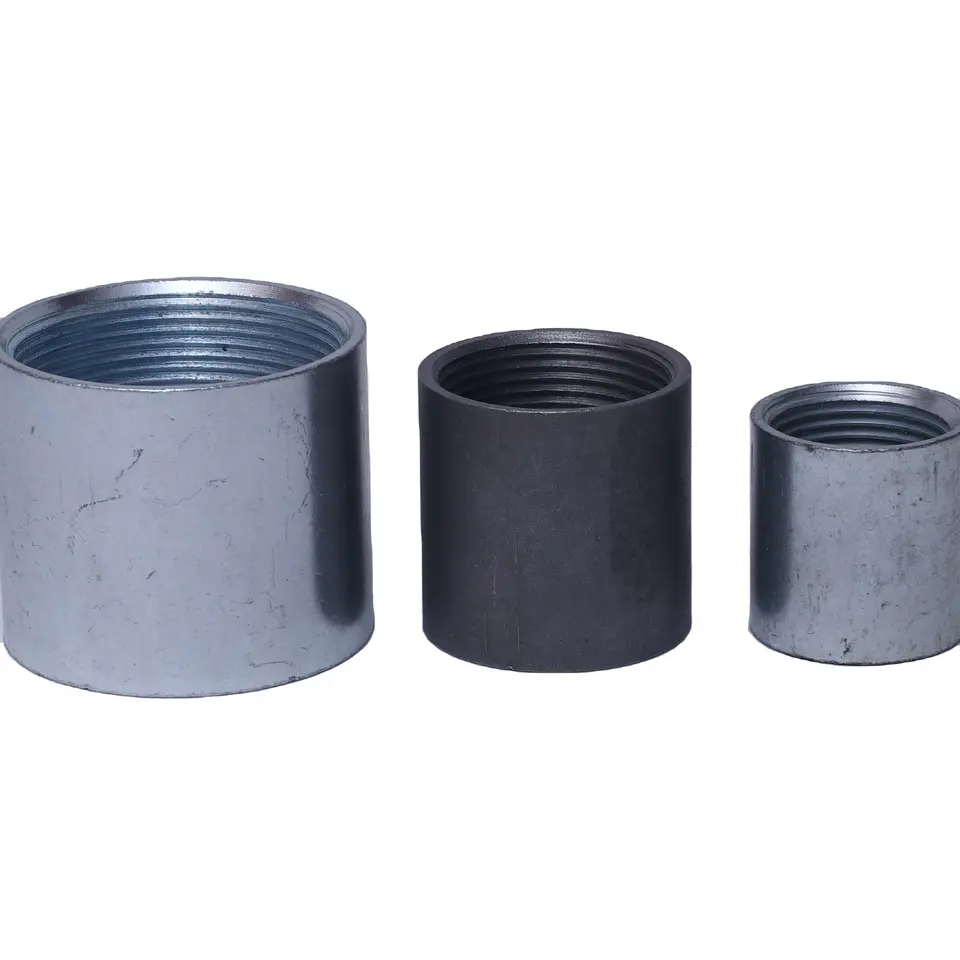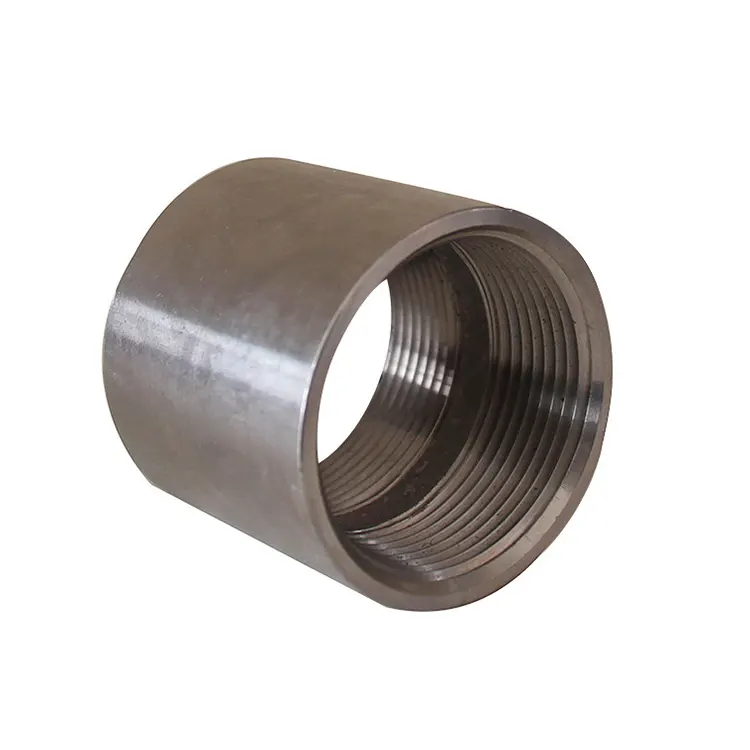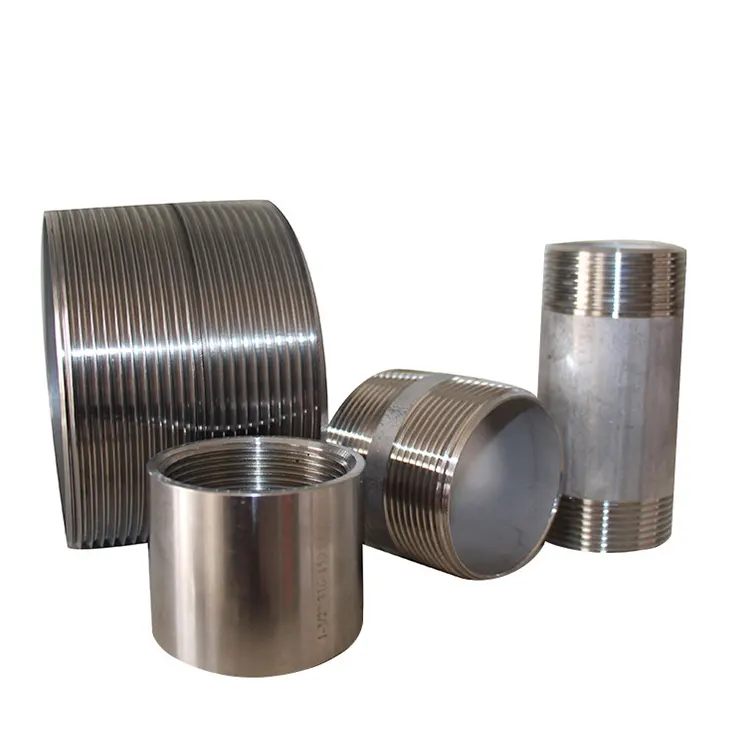Product Description
| LAMAT PIPING – Wrought Steel Fittings | ||
| Name | Socket/Coupling,Reducing Socket/Coupling,Elbow,Street Elbow,Tee,Bushing,Union,Bend,Cap,Plug,Cross | |
| Close Nipple,Short Nipple,Shoulder nipple,Long Nipple,Running Nipple,Barrel Nipple | ||
| Technology | Wrought Steel,Casting,Forging,Welded or Seamless pipe | |
| Thickness | SCH40, SCH80, SCH160; CLASS A, CLASS B, CLASS C | |
| Pressure | 150LBS,300LBS | |
| Surface Finish | Steam Black,Electrical Zinc Plated,Cold Galvanised,Hot Dipped Galvanised… | |
| Design Standard | American Standard | ASTM A733 |
| European Standard | EN15711 | |
| British Standard | BS EN15711,BS1387,BS21,BS1740 | |
| Germany Standard | DIN2982,DIN2440 | |
| ISO Standard | ISO 49,IS1879 | |
| Thread Standard | ASME B.1.20.1 / EN15716 / DIN2999 / ISO7-1 / ISO228 / IS554 / BS EN15716 / BS 21.173 | |
| Material Standard | ASTM A106/A53 GR.B,API 5L GR.B,ASTM A105 | |
| Size | 1/2″-8″ // DN15-DN200 | |
| Packages | Plywood Cases or Plywood Pallets or Boxes | |
| Application | Petrochemical & Gas Industry,Chemical,Machinery,Electric Power,Ship Building,Construction Water Works,Valve Industry,etc. | |
| Advantages | High Quality + Ready Stock + Faster Delivery + Customized | |
| Brand | LMP | |
| Certificate | ISO9001,API,CE,UL/FM | |
Factory & Workshop Show
Production Process Show
Company Profile
WHO WE ARE
Lamat Piping established in 2002s,is 1 of China’s leading piping manufacturing and exporting suppliers,specialized in qualified steel flanges, butt weld pipe fittings and malleable cast iron fittings for clients from over 60 countries and regions worldwide.
Lamat Piping is the single and independent exporting department of NPCC(National Piping Construction Cooperation),who is a group company with 5 factories located in ZheJiang and ZheJiang , where the regions have very long histories in manufacturing Steel & Iron products dating back to 1990s. CHINAMFG Piping(NPCC) aims to combine and intergrade some leading and high quality industries to become a modern and international piping supplier in the new century. Now we have more than 30 producing and machining lines with over 1000 normal workers and 80 technical employees. Our factories covers over 300,000 square meters,and has an annual output of 500,000Tons.
WHAT WE PRODUCE
Lamat Piping(NPCC) is producing flanges from 1/2” to 144” – Standards including ASTM B16.5, EN1092-1, BS4504, BS10, SANS1123, DIN, JIS, UNI, GOST, KS, AS, etc. Products including Plate Flanges FF/RF, Slip On Flanges FF/RF, Blind Flanges FF/RF, Welding Neck Flanges, Screwed Flange, Socketed Flanges, Lap Joint Flanges,Backing Rings Flanges,etc. Pressures includes 150LBS to 2500LBS in ASTM B16.5,PN6(T6/3/4/8) to PN100(T100/3/4/8) in EN1092-1/BS4504/BS10, T600/3/4/8 to T4000/3/4/8 in SANS1123.
Lamat Piping(NPCC) is producing butt weld fittings from 1/2” to 144” – Standards including ASTM B16.9, JIS B2311, EN15713, DIN, GOST…etc. Products including 45/90/180 Degree Short/Long Radius Elbow,Equal/Reducing Tee,Cross,Concentric/Eccentric Reducer,End Cap.
Lamat Piping(NPCC) is also producing malleable cast iron fittings from 1/2” to 6” – Standards ASME B16.3, ASME B16.14,BS EN15712,BS1256,DIN2950, BNR6943, ISO49,etc. Products including Elbow,Bend,Tee,Socket,Nipple,Bushing,Union,Cap,Plug,Back Nut.
WHAT WE SOURCE
With 30+ years constant efforts and experience,now CHINAMFG Piping(NPCC) has become our customers’ expert manufacturer and supplier for a very wide range of piping products.And today CHINAMFG Piping is not only supplying Flanges,BW fittings & Malleable Iron Fittings produced by ourselves,but also sourcing and exporting various Pipe Fittings & Valves s from China’s leading industries,including Cast Iron Valves, Ductile Iron Pipe Fitting, Stainless Steel 1,2,3PC Ball Valve, Stainless Steel 150LBS NPT/BSP Fittings, Wrought Steel Fittings,Grooved Fittings,Forged Steel Fittings,HDPE Pipes Fittings Valves,PVC Pipes Fittings Valves, Brass Valves Fittings,etc.
WHAT WE PROMISE
”BETTER QUALITY, BETTER SERVICES” is our promise to all of our customers and ”CREATE VALUE FOR CUSTOMERS” is our ultimate goal. CHINAMFG Piping promises that we’ll continue to put quality in the first place;besides,we will not lose our fixed-focus on the service aspect of our business,which has been,and will continue to be the foundation of our success and our future growth.
WHAT YOU CHOOSE
If you’d like to trust CHINAMFG Piping,Lamat people will do the best to be worthy of your trust!
Products Details
Packaging & Shipping
Samples Room Show
Canton Fair & Exhibitions
FAQ
| Q0: Are you a factory or trading company? | ||
| A: We are a factory mainly producing pipe fittings & flanges. We also have cooperated factories to supply other piping products. | ||
| Q1: How do your Control the Quality? | ||
| A: We have QA & QC department who will follow up all the producing process to make sure we’re supplying correctly. | ||
| Q2: What Machines are you using for Manufacturing and Machining? | ||
| A: We have Forging/Stamping Machine,CNC Machine,Hole-Drilling Machine,Sandblasting Machine. All producing is in our factory except Galvanization. | ||
| Q3: Can we get Samples for Testing? | ||
| A: Yes,sapmles are supplied free of charge. | ||
| Q4: Can you accept OEM & marking our LOGO? | ||
| A: Yes,no problem if you can provide Authorization. | ||
| Q5: Can you offer Drawings & Datasheets? | ||
| A: Yes,Drawings & Datasheets will be sent for your confirmation before Bulk Production. | ||
| Q6: Can you supply MTC with EN15714 3.1/3.2 Certificate? | ||
| A: Yes,MTC will be provided after production is finished. | ||
| Q7: Can we visit your factory to inspect the goods before delivery? | ||
| A: Yes sure. Welcome to our factory,and we also accept Third Party Inspection like SGS,TUV,BV,etc. | ||
| Q8: Can you combine goods from our other suppliers to ship together? | ||
| A: Yes,we’d like to assist you to ship together to save your time and money. | ||
| Q9: How long is your Delivery Time? | ||
| A: It depends on quantity and products. It can be delivered in 1 week if we have Ready-Stock; if not,the General Production Time is 25 – 50 Days. | ||
| Q10: What’s your Payment Terms? | ||
| A: Currently we’re working with our clients under T/T,L/C,O/A,Western Union,etc. |
/* January 22, 2571 19:08:37 */!function(){function s(e,r){var a,o={};try{e&&e.split(“,”).forEach(function(e,t){e&&(a=e.match(/(.*?):(.*)$/))&&1
What are the Signs of Wear, Corrosion, or Damage in a Half Coupling?
A half coupling, like any other pipe fitting, can experience wear, corrosion, or damage over time due to various factors. Regular inspection is crucial to detect any issues early on and prevent potential leaks or failures in piping and plumbing systems. Here are some signs to look for to identify wear, corrosion, or damage in a half coupling:
- Visible Corrosion: Check for any signs of rust or corrosion on the surface of the half coupling. Corrosion can weaken the material and lead to leaks or structural failure. Surface discoloration, rough patches, or flaking of the metal are all indicators of possible corrosion.
- Thread Damage: For threaded half couplings, inspect the threads carefully. Look for signs of stripping, galling, or deformation. Damaged threads can compromise the integrity of the connection and may result in leaks.
- Cracks or Fractures: Examine the half coupling for any cracks, fractures, or signs of deformation. Cracks can lead to leaks and should be addressed immediately to prevent further damage.
- Worn Socket or Weld Seam: In the case of socket weld or butt weld half couplings, inspect the socket or weld seam for signs of wear or damage. A worn socket may not provide a secure fit for the smaller pipe, while defects in the weld can compromise the joint’s strength and integrity.
- Leaks: Any visible leaks or indications of moisture around the joint or coupling are clear signs of a problem. Leaks can be caused by damaged threads, corroded surfaces, or improper installation.
- Reduced Performance: If the system’s performance declines, such as a decrease in flow rate or pressure, it could be a sign of a partially obstructed or damaged coupling.
- Age and Service Life: Consider the age and service life of the half coupling. Over time, even well-maintained couplings may show signs of wear and fatigue, warranting closer inspection.
If any of these signs are observed, it is essential to take prompt action to address the issues. Depending on the severity of the wear, corrosion, or damage, the appropriate steps may include repairing or replacing the half coupling. In some cases, it may be necessary to inspect adjacent pipes and components for possible effects of the compromised coupling.
Regular maintenance and inspection practices can help identify signs of wear, corrosion, or damage in a half coupling before they escalate into more significant problems. Following manufacturer’s guidelines, adhering to industry standards, and using suitable materials for the application can contribute to the longevity and reliability of the half coupling and the entire piping or plumbing system.
How do you Select the Right Half Coupling Material Based on the Fluid or Gas being Conveyed?
Choosing the appropriate material for half couplings is essential to ensure their compatibility with the fluid or gas being conveyed. The selection process involves considering several factors related to the nature of the conveyed substance and the specific operating conditions. Here’s a step-by-step guide on how to select the right half coupling material:
- Identify the Conveyed Fluid or Gas: Determine the type of fluid or gas that will flow through the piping system. Different materials may be required depending on whether the conveyed substance is water, oil, gas, chemicals, steam, or any other medium.
- Consider the Chemical Compatibility: Evaluate the chemical properties of the conveyed substance. Some fluids or gases can be corrosive or reactive with certain materials. Look for half coupling materials that are chemically resistant to the specific medium to prevent degradation or premature failure.
- Assess the Temperature and Pressure: Take into account the operating temperature and pressure of the system. High-temperature fluids or gases may require materials with excellent heat resistance, while high-pressure applications demand strong and durable coupling materials that can withstand the stress.
- Check for Abrasion or Erosion: In systems where the conveyed substance contains solid particles or abrasive materials, consider half coupling materials with good wear resistance to prevent premature wear and damage to the coupling surface.
- Verify Material Standards: Ensure that the selected half coupling material complies with relevant industry standards such as ASTM, ASME, API, or ISO. These standards define the material’s properties and performance criteria, providing a reliable benchmark for quality and suitability.
- Consider Environmental Conditions: Evaluate the environmental factors that can affect the coupling’s performance, such as humidity, UV exposure, or exposure to harsh chemicals. Choose materials with appropriate coatings or properties to withstand the specific environmental conditions.
- Factor in Cost and Availability: Balancing performance requirements with cost considerations is essential. Select a half coupling material that meets the necessary performance criteria while fitting within the project’s budget. Additionally, ensure that the chosen material is readily available for procurement.
Common materials used for half couplings include carbon steel, stainless steel, alloy steel, brass, bronze, and various plastics such as PVC, CPVC, and PTFE. Each material has its advantages and limitations, making the selection process critical for a successful and reliable piping system.
By carefully considering the conveyed fluid or gas, chemical compatibility, temperature, pressure, abrasion resistance, and other relevant factors, you can make an informed decision and select the right half coupling material that will ensure a safe and efficient operation of the piping system.
Can a Half Coupling be Used to Join Pipes of Different Diameters?
Yes, a half coupling can be used to join pipes of different diameters in piping and plumbing systems. Half couplings are specifically designed to connect two pipes of different sizes, making them ideal for creating transitions or connections between pipes with varying diameters. The larger end of the half coupling is welded or screwed onto the larger diameter pipe, providing a stable base for the connection. The smaller pipe, which has a different diameter, is then threaded or inserted into the smaller end of the half coupling.
The ability to join pipes of different diameters is one of the main advantages of using half couplings. This feature allows for efficient and smooth transitions between pipe sizes, which is crucial in maintaining proper fluid flow, reducing pressure losses, and preventing turbulence within the system.
Here are some common scenarios where half couplings are used to join pipes of different diameters:
- Reducing Pipe Size: When a pipeline needs to change from a larger diameter to a smaller diameter, a half coupling can be employed to create a smooth transition. For example, if a process requires a reduction in flow rate, a smaller pipe can be connected to the main pipeline using a half coupling.
- Connecting Equipment or Valves: In many industrial applications, equipment, valves, or instruments are connected to the main pipeline using half couplings. Often, these components have different pipe sizes than the main pipeline, and a half coupling provides a secure and leak-proof joint.
- Repair and Maintenance: During repair or maintenance operations, a damaged section of the pipeline can be cut out, and a new pipe of a different diameter can be connected using a half coupling. This allows for quick repairs without having to replace the entire pipeline.
When using a half coupling to join pipes of different diameters, it is essential to ensure that the threads and dimensions of the coupling match the pipes being connected. Proper sealing techniques, such as using thread sealant or Teflon tape, should also be applied to prevent leaks and ensure a reliable connection.
In conclusion, half couplings are versatile pipe fittings that enable the joining of pipes with different diameters. Their ability to facilitate smooth transitions and secure connections makes them invaluable in various industrial, commercial, and residential applications.
editor by CX 2024-04-16




